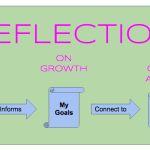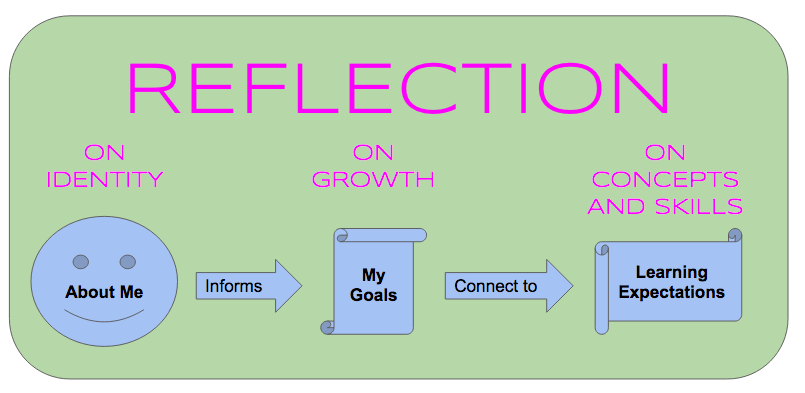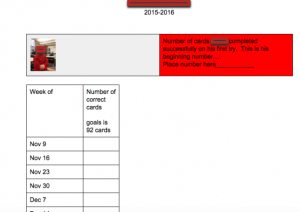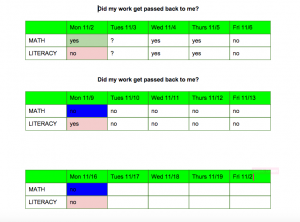Life’s four guidelines for goal-setting
 In my experience as a teacher and administrator, I noticed a pattern to goal-setting in my school and classroom. We would do some good goal-setting at the beginning of the year and then at some point during the dark depths of winter I would realize that I was too overwhelmed or embarrassed to try to resurrect them.
In my experience as a teacher and administrator, I noticed a pattern to goal-setting in my school and classroom. We would do some good goal-setting at the beginning of the year and then at some point during the dark depths of winter I would realize that I was too overwhelmed or embarrassed to try to resurrect them.
There were some notable instances when goals were powerful for students, though.
In those cases I saw the potential of goals to cultivate so many important things in my students: self-direction, a sense of efficacy, and a connection to schooling, to name a few.
Helping students set good goals is a laudable goal (ha).
But it’s surprisingly hard to do well.
Working with and learning from the educators in Washington West Supervisory Union, where students are working on goals as part of their Personalized Learning Plans (PLPs), I’ve extrapolated a few simple guidelines about the goal-setting process:
- Provide a structured goal-setting process
- Emphasize personally meaningful goals
- Consult with students individually
- Give time for goal-setting, pursuing, and reflecting
Note that those guidelines are not in any particular order. But let’s take a look at each one.
Life’s Four Guidelines for Goal-Setting
-
Provide structure
Crossett Brook Middle School piloted PLPs last year. One of their major findings was that students needed a lot of guidance on goals, as you can see in this video that captures some staff and student reflections on the pilot.
It seems pretty clear from the video and from everything we know about young adolescents that they don’t want a bunch of worksheets to form the basis of their goal setting. Yet some explicit treatment of goals can be very helpful. This introductory presentation on SMART goals from Fayston Elementary School is a good example of how to kick things off in a fun but substantive way.
The key is to provide structure without overcomplicating it. This goal-setting sheet from the PLP Pathways website provides a fairly simple protocol for students to work toward a SMART goal.
2. Emphasize personally meaningful goals
Meaningful goal-setting is good goal-setting
The more meaningful a goal, the more powerfully it can support student growth.
We want to help students set goals that are informed by their identity, including their interests and their learning profile. Then the goal can guide student growth and can also connect student identity to the expectations of school (i.e., transferrable skills, content standards, behavioral rules, etc.).

One way to ensure the personal connection is to start with personal goals. Sara Huff, special education teacher at Crossett Brook, used a significant amount of advisory time during the first several weeks of school for students to research their passions. Here’s a September excerpt from her personal reflective blog:
“Next week, we’re starting to finally use Blogger to reflect on their process to far – their passion/cool exploration idea, and where they are in figuring out what they’re going to do. I plan to have them blog every week for about 10 minutes on where they are. We’ll set a goal without mentioning the word goal, and figure out the steps to get there without showing them any PLP form.
My hope is that when we put it in the PLP form, they will have already experienced all the parts, and blogged about them. I really like backwards design and this process lets me practice it.”
Recently she has introduced the SMART goal structure and students have been able to successfully transition their projects into detailed goal statements and action steps, which they will share with parents during student-led conferences.
3. Consult with students individually
Whether you start with a structured SMART goal format, or use stealth scaffolding to build from their passions, students will need some one-on-one time with an adult to think through their goals and action steps.
This relates to the issue of not overcomplicating things. Sitting down with a student to work on a simple SMART goal template may be the best support that you can provide. In particular, students usually need help with the “M is for Measurable” part of SMART, and adults can be particularly helping students create tools to track progress (and then reviewing progress!).
Simple logs, such as the ones shown above, from Moretown Elementary School, can be great ways for students to track progress.
Crossett Brook made one-on-one consultation possible by creating activities during advisory where advisors could send some of their students and free up time to work individually with others. Many schools in the district have created work sessions when multiple adults are available for consultations. As students gain skills in goal setting, they will be able to provide more of this consultation for each other as well.
4. Give time for goal-setting, pursuing and reflecting
Students simply need time to devote to goals. That includes not just the initial goal setting but also time to pursue their goals in school.
At Warren Elementary School, students set a goal every week. This investment of time builds the skills that students need to set longer term goals. It also provides students with a constant reminder that goal setting is an ongoing process that requires follow through.
At Waitsfield Elementary, students set a number of goals at the beginning of the year and then picked one as a focus goal in their PLP. In addition to the SMART goals structure, students were asked to consider which aspect of the goal they would work on during school time. Students are given time each week dedicated to their goals when they can:
- Pursue goal by engaging in action steps
- Capture evidence of growth on blog or PLP
- Reflect on progress and refine action steps
What makes for good goal-setting in a PLP?
Students are empowered when they can pursue goals during school time. This is an important step in the direction of allowing student goals and PLPs to fulfill their positive potential, as vehicles for schools to support students as self-directed learners.




What makes for good goal-setting in a PLP? #vted https://t.co/iJgCavZj65 https://t.co/Ee2GcanzrI
RT @innovativeEd: What makes for good goal-setting in a PLP? #vted https://t.co/iJgCavZj65 https://t.co/Ee2GcanzrI
What makes for good goal-setting in a PLP? https://t.co/CY1jzNlM5O via innovativeEd
RT @innovativeEd: What makes for good goal-setting in a PLP? #vted https://t.co/iJgCavZj65 https://t.co/Ee2GcanzrI
What makes for good goal-setting in a PLP? https://t.co/qBbKPD3B2L # great post from @innovativeEd
For the afternoon crowd: @lifelegeros on goal-setting in a PLP https://t.co/OQmQtp53We #wwsu
RT @innovativeEd: For the afternoon crowd: @lifelegeros on goal-setting in a PLP https://t.co/OQmQtp53We #wwsu
RT @innovativeEd: For the afternoon crowd: @lifelegeros on goal-setting in a PLP https://t.co/OQmQtp53We #wwsu
What makes for good goal-setting in a PLP? https://t.co/g9LFzEfMcG via @innovativeEd
What makes for good goal-setting in a PLP? https://t.co/tM8SEpQMuw from @lifelegeros
What makes for good goal-setting in a PLP? https://t.co/eTlEXA3NjG via @faystonedleader via @innovativeEd. #vted #edchat #PLP
RT @meg_allison: What makes for good goal-setting in a PLP? https://t.co/eTlEXA3NjG via @faystonedleader via @innovativeEd. #vted #edchat…
RT @meg_allison: What makes for good goal-setting in a PLP? https://t.co/eTlEXA3NjG via @faystonedleader via @innovativeEd. #vted #edchat…
One of the most exciting things about having students learn to set goals as middle schoolers is that by the time they reach high school, they’re really good at it. Great post!
And thank you so much for your fantastic VT Fest presentation – I learned a lot!
A great post. TOTALLY in keeping with the Principle of Expression and Action (to say nothing of Engagement) in Universal Design for Learning. I’m going to use this in my college teaching!
Fantastic! Please let me know how it goes.